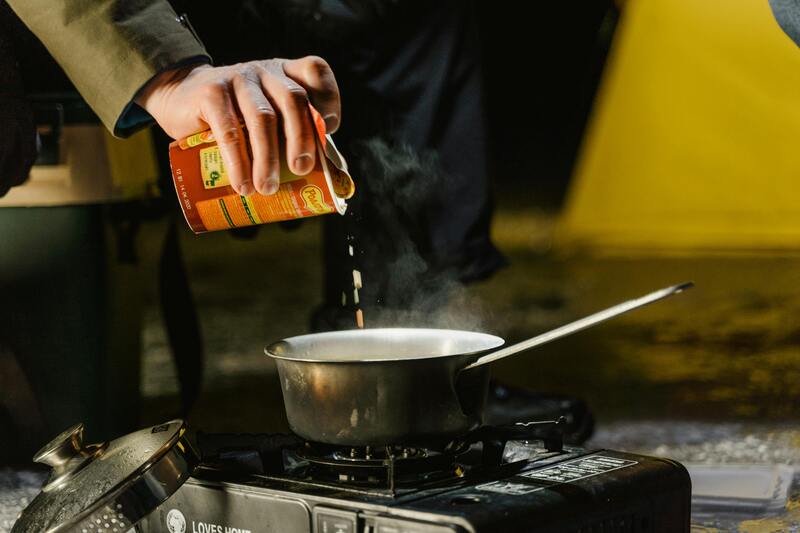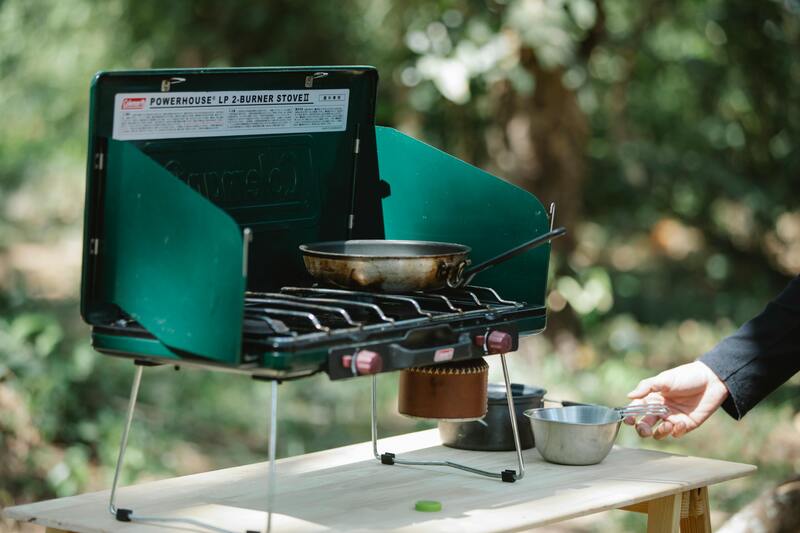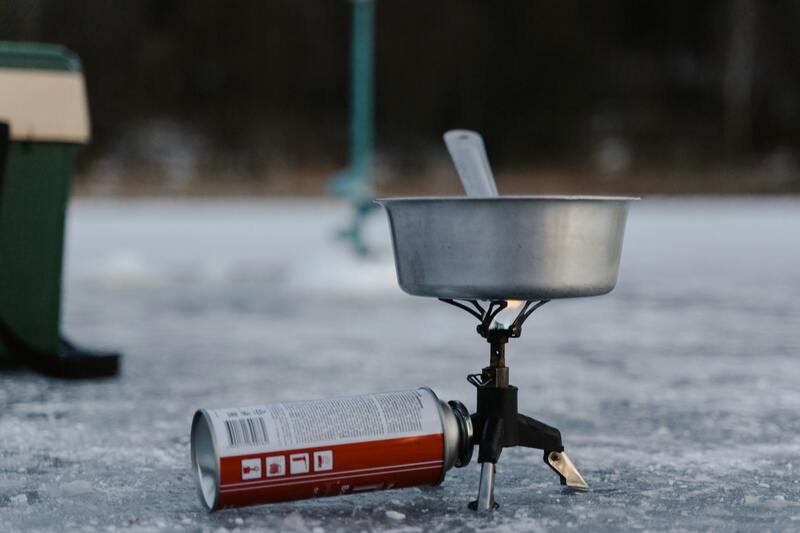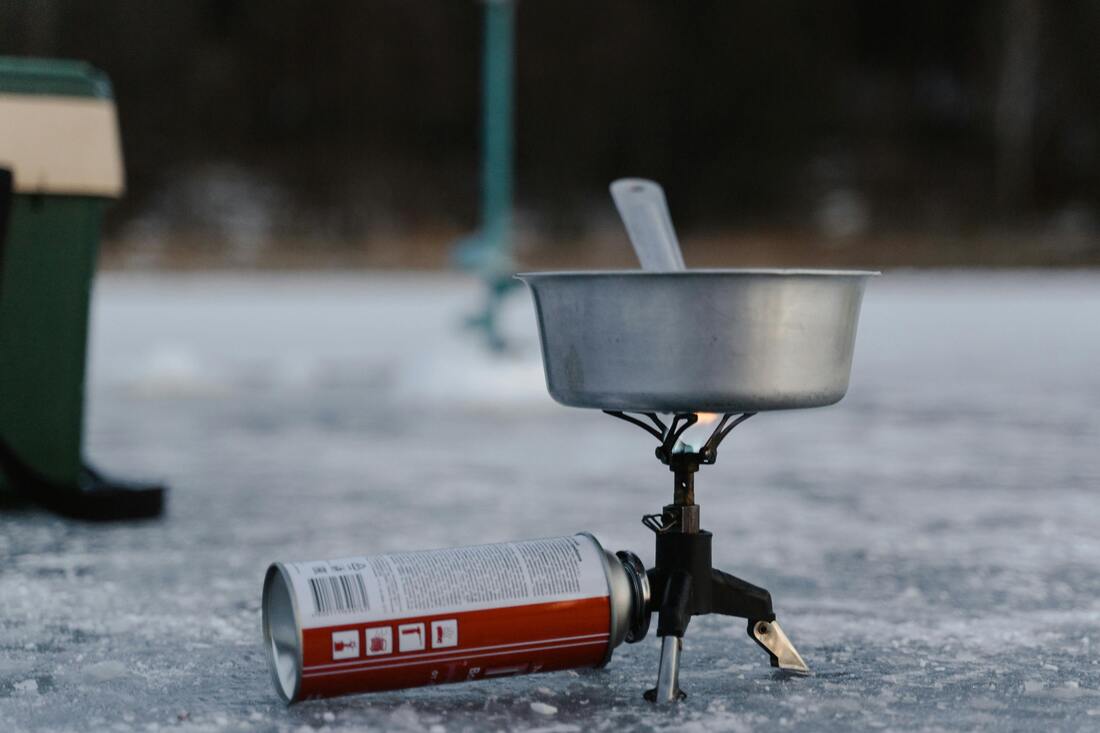**Camping Stoves: A Quick Guide**
* **Canister Stoves:**
* What they are: Small stoves that screw onto gas cans.
* Great for: Backpacking alone because they're light.
* Keep in mind: They don't work well when it's cold, and you can't find fuel everywhere.
* **Liquid Fuel Stoves:**
* What they are: Stoves that use gas or kerosene.
* Great for: Long trips where you can't get gas cans.
* Keep in mind: You have to get them ready before using them, and they're bigger than canister stoves.
* **Alcohol Stoves:**
* What they are: Stoves that burn alcohol.
* Great for: People who want to pack light.
* Keep in mind: They don't get very hot, so cooking takes longer. Wind can also blow them out.
* **Wood-Burning Stoves:**
* What they are: Stoves that use twigs for fuel.
* Great for: Those who care about the environment, if there's wood around.
* Keep in mind: You can't use them when there are fire bans or if it's wet. They're also slow.
* **Multi-Fuel Stoves:**
* What they are: Stoves that use gas, liquid fuel, or alcohol.
* Great for: People going to other countries.
* Keep in mind: They're heavy, and you have to clean them.
**What to Look For:**
* **Heat:** More heat means faster cooking, but you'll use more fuel.
* **Starting:** Some stoves have a button to light them, but it might not work in the wind. If not, you'll need a lighter.
* **Wind:** Some stoves block the wind so the flame doesn't go out.
* **Low Heat:** If you want to cook something that needs low heat, get a stove that lets you control the flame.
* **How Long it Lasts:** Get a stove made of steel or metal. Make sure the legs are strong.
**Which Stove Should You Pick?**
* **Backpacking Alone:** Get a light gas or alcohol stove.
* **Camping with Friends:** Get a liquid fuel stove with a few burners, so you can cook a lot of food at once.
* **Cold Weather:** Gas or liquid fuel stoves are the best.
* **Saving the Earth:** Use a wood-burning stove, but only if it's dry.
**Be Safe!**
* Always cook where there's air so you don't breathe in bad fumes.
* Put your stove on something level.
* Keep fuel away from heat.
* Check for leaks and clean the burners.
* **Canister Stoves:**
* What they are: Small stoves that screw onto gas cans.
* Great for: Backpacking alone because they're light.
* Keep in mind: They don't work well when it's cold, and you can't find fuel everywhere.
* **Liquid Fuel Stoves:**
* What they are: Stoves that use gas or kerosene.
* Great for: Long trips where you can't get gas cans.
* Keep in mind: You have to get them ready before using them, and they're bigger than canister stoves.
* **Alcohol Stoves:**
* What they are: Stoves that burn alcohol.
* Great for: People who want to pack light.
* Keep in mind: They don't get very hot, so cooking takes longer. Wind can also blow them out.
* **Wood-Burning Stoves:**
* What they are: Stoves that use twigs for fuel.
* Great for: Those who care about the environment, if there's wood around.
* Keep in mind: You can't use them when there are fire bans or if it's wet. They're also slow.
* **Multi-Fuel Stoves:**
* What they are: Stoves that use gas, liquid fuel, or alcohol.
* Great for: People going to other countries.
* Keep in mind: They're heavy, and you have to clean them.
**What to Look For:**
* **Heat:** More heat means faster cooking, but you'll use more fuel.
* **Starting:** Some stoves have a button to light them, but it might not work in the wind. If not, you'll need a lighter.
* **Wind:** Some stoves block the wind so the flame doesn't go out.
* **Low Heat:** If you want to cook something that needs low heat, get a stove that lets you control the flame.
* **How Long it Lasts:** Get a stove made of steel or metal. Make sure the legs are strong.
**Which Stove Should You Pick?**
* **Backpacking Alone:** Get a light gas or alcohol stove.
* **Camping with Friends:** Get a liquid fuel stove with a few burners, so you can cook a lot of food at once.
* **Cold Weather:** Gas or liquid fuel stoves are the best.
* **Saving the Earth:** Use a wood-burning stove, but only if it's dry.
**Be Safe!**
* Always cook where there's air so you don't breathe in bad fumes.
* Put your stove on something level.
* Keep fuel away from heat.
* Check for leaks and clean the burners.
🌬️ Things to Think About When Camping:
Wind
Wind can mess with your stove, making it less good and maybe blowing out the flame.
Try to find a spot that's blocked from the wind, like behind rocks or logs. You can also get those little shields that go around your stove.
Don't put your stove in a hole in the ground because smoke can build up there.
Cold Weather
If it's freezing, those stoves with the gas cans don't work as well because the pressure drops.
Stoves that use liquid fuel are better when it's cold or you're up high.
Warming up the fuel a bit can help.
High Up
When you're way up in the mountains, the air is thinner, so your stove might not burn as well.
Liquid fuel stoves don't care as much about the altitude.
⚙️ Getting Your Stove Ready:
Keep it Steady
Always put your stove on something that's flat and won't catch fire.
If the ground is bumpy, use a small camping table or a flat rock.
Hooking Up the Fuel
Canister stoves: Screw the can on carefully so you don't mess up the threads. Make sure it's not leaking.
Liquid fuel stoves: Pump it up or get it ready like the instructions say. You might need to prime it.
Lighting It
If you light it yourself, have a lighter or waterproof matches ready.
Those stoves with the button (piezo igniter) are easy, but bring a backup in case it stops working.
Cooking Stuff
Heat up your pans first, so food doesn't stick and it cooks quicker.
Use lids on your pots to keep the heat in and use less fuel.
Cook things on low heat, so you don't burn the food or break the stove.
🧹 Taking Care of Your Stove:
Cleaning
Clean the burners now and then to keep them from getting clogged.
Wipe off any black stuff from your pans and the stove.
Putting It Away
Empty out liquid fuel stoves before you store them.
Keep the fuel cans standing up in a cool, dry place.
Look for cracks in the seals and rubber rings.
Problem Solving
Weak flame: Check the fuel, clean the burner holes, and look at the seals.
Fuel leaking: Turn it off right away and take it apart. Find the broken part and replace it.
Won't light: Try lighting it with a match. If it has a button, check that thing.
🍳 Cooking Tips:
Be Efficient
Only boil as much water as you need.
Use pots that are light and skinny to save fuel.
One-Pot Wonders
Make stews, pasta, or rice. It's easier to clean up and uses less fuel.
Cook a Lot
Make a big meal and eat it for a few days to save fuel.
Heat Control
Use low heat for foods that burn easily.
High heat is good for boiling water or frying stuff.
🔄 Fancy Stoves:
All-in-One Stoves
The stove and pot are made to fit together, so heat transfers better to save time.
Stoves with a Hose
The fuel can is connected with a hose. This makes it more stable for big pots.
Stoves That Don't Tip
They have wide bases or legs to help with heavy pots and bumpy ground.
🛡️ Quick Safety Check Before You Cook:
Clear away any dry leaves or grass.
Have a fire extinguisher, water, or sand nearby.
Never leave a burning stove by itself.
Only use the stove outside or in a place with good air.
I can also make a guide to camping stove
Wind
Wind can mess with your stove, making it less good and maybe blowing out the flame.
Try to find a spot that's blocked from the wind, like behind rocks or logs. You can also get those little shields that go around your stove.
Don't put your stove in a hole in the ground because smoke can build up there.
Cold Weather
If it's freezing, those stoves with the gas cans don't work as well because the pressure drops.
Stoves that use liquid fuel are better when it's cold or you're up high.
Warming up the fuel a bit can help.
High Up
When you're way up in the mountains, the air is thinner, so your stove might not burn as well.
Liquid fuel stoves don't care as much about the altitude.
⚙️ Getting Your Stove Ready:
Keep it Steady
Always put your stove on something that's flat and won't catch fire.
If the ground is bumpy, use a small camping table or a flat rock.
Hooking Up the Fuel
Canister stoves: Screw the can on carefully so you don't mess up the threads. Make sure it's not leaking.
Liquid fuel stoves: Pump it up or get it ready like the instructions say. You might need to prime it.
Lighting It
If you light it yourself, have a lighter or waterproof matches ready.
Those stoves with the button (piezo igniter) are easy, but bring a backup in case it stops working.
Cooking Stuff
Heat up your pans first, so food doesn't stick and it cooks quicker.
Use lids on your pots to keep the heat in and use less fuel.
Cook things on low heat, so you don't burn the food or break the stove.
🧹 Taking Care of Your Stove:
Cleaning
Clean the burners now and then to keep them from getting clogged.
Wipe off any black stuff from your pans and the stove.
Putting It Away
Empty out liquid fuel stoves before you store them.
Keep the fuel cans standing up in a cool, dry place.
Look for cracks in the seals and rubber rings.
Problem Solving
Weak flame: Check the fuel, clean the burner holes, and look at the seals.
Fuel leaking: Turn it off right away and take it apart. Find the broken part and replace it.
Won't light: Try lighting it with a match. If it has a button, check that thing.
🍳 Cooking Tips:
Be Efficient
Only boil as much water as you need.
Use pots that are light and skinny to save fuel.
One-Pot Wonders
Make stews, pasta, or rice. It's easier to clean up and uses less fuel.
Cook a Lot
Make a big meal and eat it for a few days to save fuel.
Heat Control
Use low heat for foods that burn easily.
High heat is good for boiling water or frying stuff.
🔄 Fancy Stoves:
All-in-One Stoves
The stove and pot are made to fit together, so heat transfers better to save time.
Stoves with a Hose
The fuel can is connected with a hose. This makes it more stable for big pots.
Stoves That Don't Tip
They have wide bases or legs to help with heavy pots and bumpy ground.
🛡️ Quick Safety Check Before You Cook:
Clear away any dry leaves or grass.
Have a fire extinguisher, water, or sand nearby.
Never leave a burning stove by itself.
Only use the stove outside or in a place with good air.
I can also make a guide to camping stove



